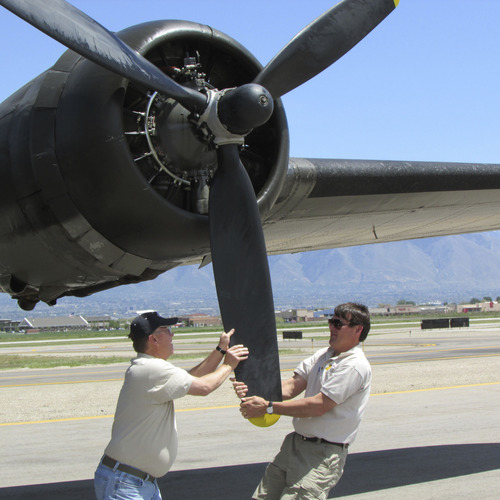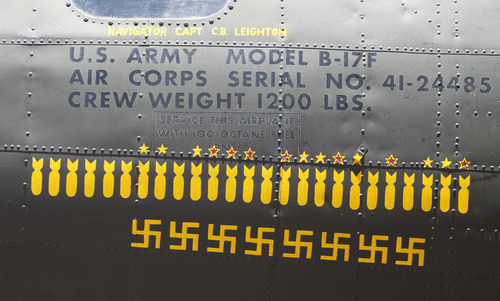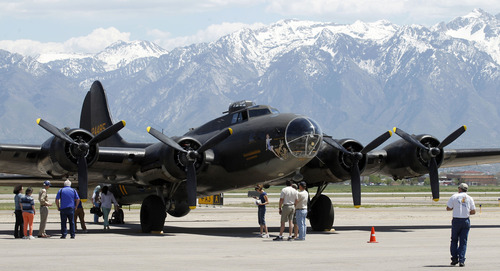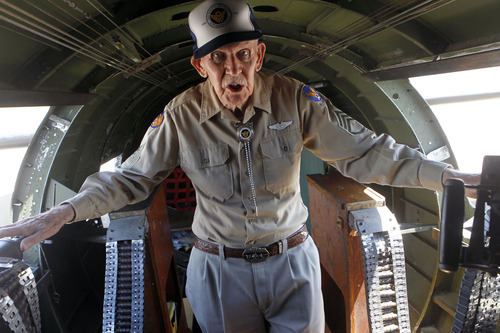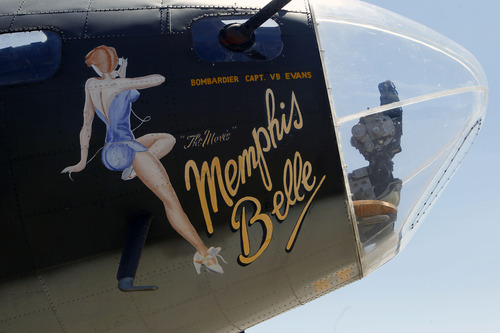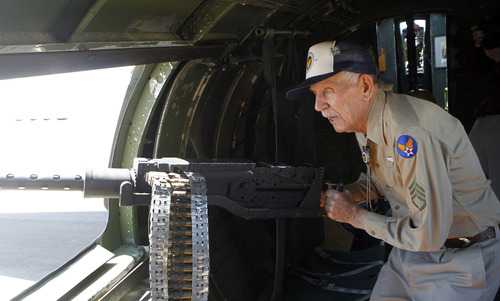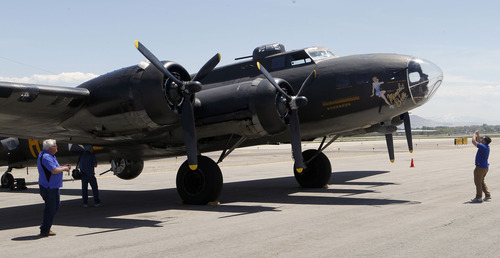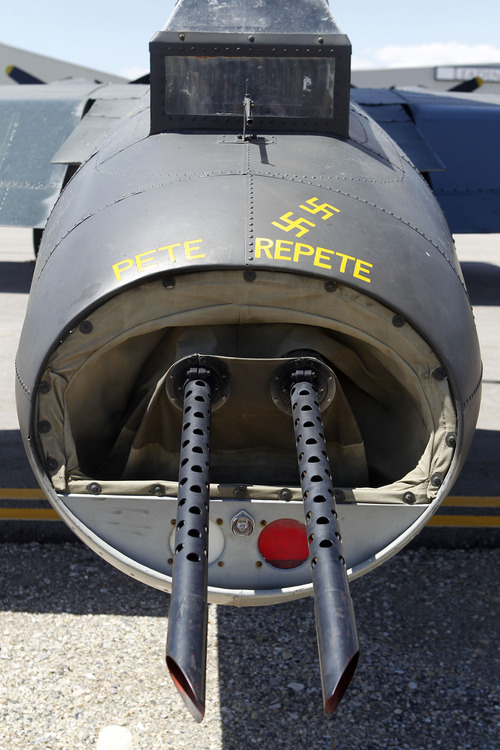This is an archived article that was published on sltrib.com in 2013, and information in the article may be outdated. It is provided only for personal research purposes and may not be reprinted.
West Jordan • As 88-year-old World War II veteran Paul Sersland got off the historic B-17 bomber Monday at the South Valley Regional Airport, he bent over and kissed the ground.
This was the first time the Layton resident had actually flown on an airplane since 1954. After surviving 35 missions over Germany as part of a 10-man bombing crew between October of 1944 and March of 1945, he simply wasn't comfortable flying. He admitted to being more than a little nervous on his last flight on a commercial plane that took him over the Grand Canyon.
"I talked with the Lord and he decided I didn't need to fly anymore," said Sersland.
One of the major reasons the Liberty Foundation brings its B-17 Flying Fortress to airports such as South Valley Regional is to help preserve the stories of veterans such as Sersland. This plane, called the Memphis Belle, was featured in the movie of the same name. It is one of only 13 B-17s that still fly today and one of only four that can carry passengers. Boeing produced 12,732 of the B-17s between 1935 and 1945, 4,735 of which were lost in combat.
The B-17 will be part of International Learn to Fly Day Saturday at Leading Edge Aviation at the South Valley Regional Airport. Events include discovery flights on small planes, a bounce house for kids and a barbecue. Public, 45-minute flights on the Memphis Belle are available for $450 both Saturday and Sunday morning. After the flights, the public can tour the inside of the plane with donations accepted.
Before Monday's flight, Sersland asked Tom Ward, a Sunday school teacher at the Layton Baptist Church he attends, to say a brief prayer.
"We never went on one bombing mission without the chaplain saying a prayer," explained Sersland, who was wearing his Army Air Corps Uniform that celebrated his unit's nickname, the Hells Angels.
The World War II veteran said that on one of the 35 raids over Germany where he served as a waist and tail gunner for the machine guns shot through open windows, German fighter planes hit the No. 1 engine. It started vibrating badly. Several feet of the plane's right wing were gone and gasoline was pouring off it. The oil pressure dropped on the No. 2 engine, which was soon lost. The plane dropped out of formation, becoming a "straggler" vulnerable to being shot down by the Germans.
After finishing his first flight in 59 years, Sersland's reaction wasn't that much different than when he completed his 35th final mission after World War II.
"This reminded me of who brought me back," he said. "The Lord brought me back. I had work still left to do. Not too many completed all 35 bombing missions. The odds are pretty slim to make it all the way. I was extremely fortunate...This brought back a lot of old memories of people I flew with."
The flights were difficult. Because the planes were open to the outside air, temperatures could drop to as low as 60 or 70 below zero. Crews had to wear heated suits and clothing and worry about frostbite.
Chris Tuckfield, a United Airlines pilot who lives in Draper and has been flying this historic plane for about four years, said a veteran influenced him to be a pilot when he was growing up. He knew a man that had metal claws for hands, a metal nose and was missing an ear, who told him of his experiences in the B-17. That influenced his career.
He compared flying this plane to antique automobile lovers who restore old cars and then go out for a drive.
"This is much more pilot intensive," he said. "You have to do everything yourself."
Pilots such as Tuckfield and John Hess of Atlanta said flying this plane requires lots of upper body strength and a lot of labor, much more than on a modern aircraft.
Larry Hansen of Colorado Springs helps answer questions and do maintenance on the plane. He said there is nothing better in the world than being on this plane. He showed the ball turret where a machine gunner would operate the controls from a fetal position, his hands behind his head.
Those who would like to fly in the historic plane,which costs $4,500 per flight hour and over $1.5 million a year to maintain, can contact Scott Maher at smaher@libertyfoundation.org to make a reservation.
Twitter @tribtomwharton —
The B-17 Flying Fortress
R When the Army requested a large, multi-engine bomber, the B-17 prototype, financed entirely by Boeing, went from design board to flight test in less than 12 months. It was a low-wing monoplane that had a flight deck instead of an open cockpit and was armed with bombs and five machine guns mounted in clear "blisters." The first B-17s saw combat in 1941 and were flown by the British Royal Air Force. The B-17E mass-produced model Flying Fortress carried nine machine guns and a 5,000-pound bomb load.
The first flight of the prototype was July 28, 1935. It had a wing span of 103 feet 9 inches and was 74 feet 9 inches in length. It weighed 65,000 pounds with a top speed of 287 mph, a cruising speed of 150 mph and a range of 3,750 miles. It was powered by four 1,200-horsepower Wright R-1820-97 engines and could accommodate two pilots, a bombardier, a radio operator and five gunners. It usually had 11 to 13 machine guns.
Source: Boeing


